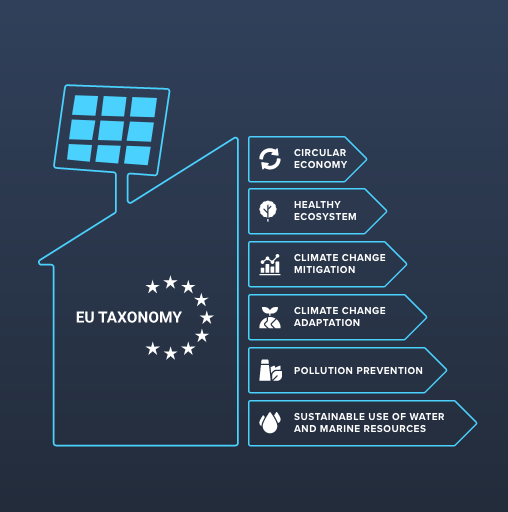First, some background: Energy performance certificates for buildings have been around for approximately 10 years. Directive 2010/31/EU of the European Parliament and of the Council of 19 May 2010 on the energy performance of buildings serves as the basis for the national implementation within the EU member states.
With the new EU Taxonomy regulation, EPCs receive new attention. The EU Taxonomy requires that sustainable economic activities document Primary Energy Demand (PED), amongst other criteria, for real estate. Not only is the documentation of PED necessary, but to demonstrate compliance with the technical screening criteria set forth, there are certain thresholds that buildings may not exceed. These thresholds are classified with “Energy performance classes” and/or derived from the national definitions of the “Nearly Zero Energy Building” (NZEB) thresholds.
Applicability of EPCs
EPCs have been mainly used to demonstrate compliance for obtaining building permits, documentation of energy efficiency improvements for renovations and for documentation purposes during transaction activities, which legally require that a valid EPC exists for the building.

Why the focus on EPCs now?
In light of the EU Taxonomy, EPCs receive a much more thorough screening because the relevance, accuracy and correctness of values within the EPC may drive investment decisions to achieve alignment with the technical screening criteria of the EU Taxonomy. In addition – and this is especially true for existing buildings – EPCs may not entirely represent the actual status of the building, due to building improvements such as e.g. LED upgrades which did not result in updates of the Energy performance certificates at the time of the lighting upgrade.
Furthermore, while EPCs may still be valid for existing buildings, they may not include primary energy demand as a key performance indicator which is assessed in the Taxonomy regulation, thus requiring an update of the EPC with new calculation methods.
For all life-cycle stages of the building, be it new construction, building operations or renovation, the adequate use of specific building criteria and conversion factors for primary energy instead of default calculation parameters set forth by national calculation methods may require some additional thoroughness and optimizations – within the legal requirements, needless to say – to represent current building performance.
Besides EU Taxonomy, energy certificates play a vital role in the assessment of buildings in green building certification systems. Especially in DGNB certification, both the environmental foot print analysis (life-cycle analysis) and life-cycle-cost evaluation have a significant impact on the sustainability scoring.
What can real estate developers, asset managers and property owners do?
Considering the dynamics of the broader sustainability requirements including ESG reporting and sustainable finance activities, a recommended first step is to establish a good data quality as a foundation of further decision making. This foundation regarding EPCs should – at a minimum – include a) all key data provided within the energy performance certificate (PED, CO2, etc.), b) the date of issue and expiration for each certificate, c) whether default or building-specific values were used for calculation purposes and d) information whether renovation activities occurred since the issuance of the EPC to understand potential optimization needs of the EPC.
We understand that managing a wide range of assets can be cumbersome and time-consuming. With blue auditor we offer a variety of features that automize many activities, ranging from bulk-import of portfolios to digitalization of EPCs to ensure the necessary data quality from single assets and entire portfolios.
We are excited to see how the markets and stakeholders will adjust their approaches towards EPCs and the role which they play in EU Taxonomy assessments.
Interested in automating sustainability reporting requirements for your asset or portfolio? Get in touch! To receive updates on sustainability topics and practical guidance sign up for our newsletter!





